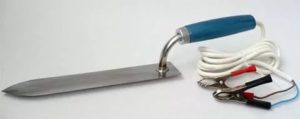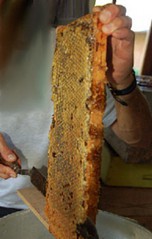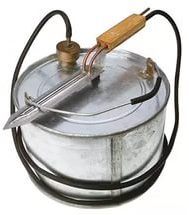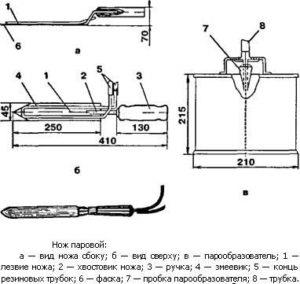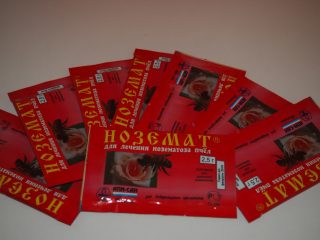Content
- 1 Apiary knife: application in beekeeping
- 2 What are the varieties
- 3 Electric comb cutter
- 4 How to make an electric apiary knife with your own hands
- 5 Steam knife for unsealing honeycombs
- 6 How to make a steam knife for printing honeycombs with your own hands
- 7 Which knife is better: steam or electric
- 8 Homemade scythe beekeeper
- 9 Safety precautions and features of working with the tool
- 10 Conclusion
The honeycomb cutter has a special shape and must be warmed up in hot water before use. The tool is convenient when used in a small apiary. If you need to print a large number of honeycombs, frequent heating in water takes a lot of time. It is more convenient to use an electric beekeeper knife or a tool that is constantly heated by steam.
Apiary knife: application in beekeeping
According to its intended purpose, a knife for opening a honeycomb is used when cutting wax outgrowths from filled frames. The apiary tool is made of metal. The blade has a special double-sided sharpening and a pointed tip for easy opening of the honeycomb. The shape of the handle is slightly curved. Blade length varies from 150 to 230 mm, width - from 35 to 45 mm. A perfectly flat plane is important. If the working blade is slightly curved, the crumbling of the notch will increase.
During operation, the apiary knife is constantly heated in hot water. The heated blade does not stick with wax, which makes it easier to unseal the honeycomb. The inconvenience of conventional beekeeping knives is associated with rapid cooling. You need to have a lot of tools at hand. While the beekeeper is working with one knife, others are warming up. The cooled beekeeping tool is changed to a heated one.
To increase productivity, use an electric or steam knife for unpacking honeycombs. Constant heating eliminates the need to keep a large number of tools close at hand.
What are the varieties
There are three types of apiary devices:
- A traditional unheated tool is heated in a container with hot water before use.
- Steam heated apiary tool. Such a steam knife is often made to unseal honeycombs from aluminum, since heat-absorbing metal tends to quickly warm up.
- Electric heated knife. Homemade beekeeping tools are often made from an old braid. There are models with a built-in 220 volt heater and a step-down transformer. An electric beekeeper knife made of stainless steel is considered safe for unpacking 12 V combs, since a safe low voltage passes along the blade.
Each model has its own pros and cons. The beekeeper individually selects a knife according to the volume of work.
Electric comb cutter
The most popular and easy-to-use comb knife is electric, which heats up when connected to a power source. The power tool is more convenient than the steam model, since the heating temperature is easy to adjust.
Electric apiary knife 220 V is considered more dangerous, since there is a threat of breakdown of insulators, electric shock. Mostly there are instruments that operate on a voltage of 12 volts through a step-down transformer. Such models cannot be plugged into a 220 volt outlet.
The power of the electric apiary knife is adjustable from 20 to 50 W, due to which the heating temperature changes - from 50 aboutFrom to 120 aboutC. The approximate weight of the beekeeping tool is from 200 to 300 g. Full heating takes about 1 minute.
Due to the fact that the electric apiary knife is automatically heated, the process of unsealing the honeycombs is accelerated. The work is going on continuously. During cutting, the blade cools down on contact with the wax. Heating to the set temperature is carried out during the break, while the beekeeper prepares a new frame.
The cut quality will always be good if the blade is kept clean. After work, it is washed with hot water. Be sure to clean off the formed carbon deposits. The blade should always shine.
Store the beekeeper's electric knife in a dry place. No tool case needed.
How to make an electric apiary knife with your own hands
Steel is required for a homemade beekeeping tool. An old braid or stainless steel sheet will do. First, a blade blank is cut out with a grinder. The length is taken 210 mm for the working part, plus another 25 mm for bending. The workpiece is cut out 45 mm wide. The strip is clamped with clamps, a small cut is made in the center with a grinder. The workpiece is clamped in teski. The section of the handle is heated with a blowtorch. When the metal heats up to a scarlet color, bend the edge of the strip with pliers.
The handle is made of fiber. First, 2 identical blanks are cut out. In one half, a groove is chosen where the copper strip is laid, chopping off a piece of the winding of the automobile starter. The element will serve as a conductor from the knife blade to the wire.
The copper strip is additionally fixed to the blade with screws for reliable contact. Flexible stranded wire is used to connect to the transformer. The section is taken about 5 mm2so that it does not warm up from the load. The halves of the handle are connected with rivets or screws.
The power source is a 12 volt transformer. You can use a car battery, but it will drain quickly. The heating temperature is controlled by a rheostat. You can change the power by adding or reducing turns of the secondary winding of the transformer. Reliable insulation is wound between the primary and secondary windings. The transformer housing together with the secondary winding is connected to ground.
Steam knife for unsealing honeycombs
By its design, the steam knife for unsealing the honeycomb resembles an electrical analogue, only a tube is fixed instead of the current-carrying busbars. It is connected with a rubber hose to the steam generator. The steam passing through the tube heats the blade and exits as condensation through another hose that is put on the other end of the tube.
The advantage of the beekeeper steam knife is quick warming up. Water does not get into honey, as is the case with a classic instrument heated with boiling water. The disadvantage is the attachment to a heat source for heating a steam generator, for example, a stove.
In the video, a homemade beekeeper steam knife:
How to make a steam knife for printing honeycombs with your own hands
The blade is made in the same way as the electrical counterpart. It is better to make a wooden handle. The wood is poorly permeable to heat. The handle will not heat up from the steam passing through the wand.
The blade heater is made from a thin copper tube. It is soldered to the plate using phosphoric acid. The tube should be located on the two edges of the blade. The steam generator is made from an aluminum can or kettle with a capacity of 5 liters. A branch pipe is attached to the hose. The connection is clamped with a hose clamp to prevent steam from blowing off the hose. The second piece of hose is put on the outlet of the copper tube that heats the blade with one end. The other end of the hose is lowered into a bucket or sink to drain the condensate.
Which knife is better: steam or electric
The steam knife and the electric knife have an attachment to the source of energy. In the first case, this is an electrical network with a step-down power supply or a battery.In the second case, the source of energy is a steam generator with a stove or fire. This attachment is a huge disadvantage of both beekeeping tools.
Which one is better, the beekeeper chooses for the convenience of work. In terms of ease of use, a factory-made or do-it-yourself electric knife for printing honeycombs wins over its fellow. It is enough to connect the apiary tool like a soldering iron to an energy source and you can work around the clock. The steam generator must be monitored so that the water does not boil away, otherwise the empty container will burn out over the fire.
Homemade scythe beekeeper
An old braid makes a good beekeeper's knife. The heating element is a soldering iron. To make a blade from a braid, a blank is cut out with a length of 150 mm and a width of 50 mm. 2 holes are drilled on one side. Rivets and steel clamps fasten the tip of a powerful soldering iron. On the working side, the heads of the rivets are grinded to the maximum in order to reduce their protrusion. The blade is sharpened on both sides. The sting is made a little with a bevel upward, so that the honeycomb is easier to cut off.
The heating of a homemade apiary knife can only be adjusted by selecting the power of the soldering iron. To prevent the blade from overheating, it is immersed in cold water between work.
Safety precautions and features of working with the tool
The opening of the honeycomb is carried out in a closed room that prevents the access of bees. Beekeeping tools of any type are first inspected for serviceability, warmed up. The cut is carried out quickly with sawing movements. The waxed blade is cleaned. If wax begins to burn on the blade, reduce the heating temperature. At the end of the work, the knife is cleaned, put away for storage.
Conclusion
The comb cutter must not be made of ferrous metals. The resulting rust will spoil the taste of the honey. If there are no suitable materials, it is better to purchase an apiary tool in a store.

